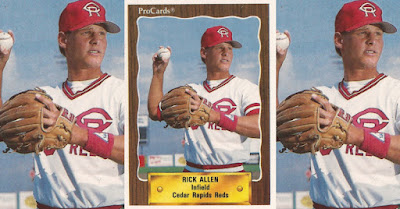 Mo Sanford couldn't believe he'd been called up to the Reds. The Padres wished he hadn't.
Mo Sanford couldn't believe he'd been called up to the Reds. The Padres wished he hadn't.In his major league debut, Aug. 9, 1991, Sanford pitched seven solid innings, gave up two hits, one unearned run and struck out eight.
"He was real tough," Padres leadoff hitter Bip Roberts told reporters afterward. "Our scouting report said his breaking ball wasn't one of his better pitches, but after that first at-bat, I told the guys, 'this boy is for real, you'd better be ready."
It was a call-up that came in his fourth year of professional ball. Sanford was a late-round draft pick by the Reds in 1988, taken in the 32nd round out of the University of Alabama.
He did well in the low minors, posting a 12-6 record at Greensboro in 1989, making the South Atlantic League All Star team. He had an even better 13-4 mark at Cedar Rapids for 1990.
Sanford was rewarded in 1991 with a promotion to AA Chattanooga, then AAA Nashville and Cincinnati in August. He started five games for the Reds that year, with an ERA under 4.
He spent 1992 back in the minors, at Chattanooga and Nashville. But a 5.68 ERA in 25 AAA starts left the Reds to leave him unprotected in the expansion draft and the Rockies took him with the 62nd pick. One reporter called Sanford's right arm powerful, one that oozed potential.
Called back to the majors that next July, Sanford got his first win as a Rockie Aug. 8, scattering five hits over seven innings. The win stopped a 13-game Rockie skid. It was also Sanford's second and final win in the majors.
Signed by the Twins in 1994, Sanford made it back to the majors for a final time in 1995. He pitched in 11 games, putting up a 5.30 ERA. He stayed on in the minors through 1996, with the Rangers.
In 1997, Sanford pitched in Taiwan. After a stint in Mexico, Sanford's playing days weren't done until 2000, after two seasons in independent leagues.
A sports reporter for The Daily Gazette in Schenectady in 2009 recalled one 1999 Sanford start with Massachusetts. Sanford gave up a run in the first, then set down 11 straight batters and 19 of 20.
More recently, Sanford has worked on instruction, opening the Southwest Ohio Baseball Academy in 2007 with partner Brian Conley.
- Kentucky New Era, Associated Press, Aug. 10, 1991: Cincy gets Mo pitching as Reds defeat Padres
- Los Angeles Times, Aug. 10, 1991: Reds' Rookie Shows He Can Mow 'Em Down
- Business Courier of Cincinnati, Sept. 14, 2007: Investors, former pros take swing at baseball academy
- Schenectady Gazette, Aug. 31, 2009: Diamond Dogs Days
Cards Reviewed: 148/880 - 16.8%
Players/Coaches Reviewed: 151
Made the Majors: 101 - 67%
Never Made the Majors: 50 - 33%
5+ Seasons in the Majors: 41
10+ Seasons in the Minors: 53



















